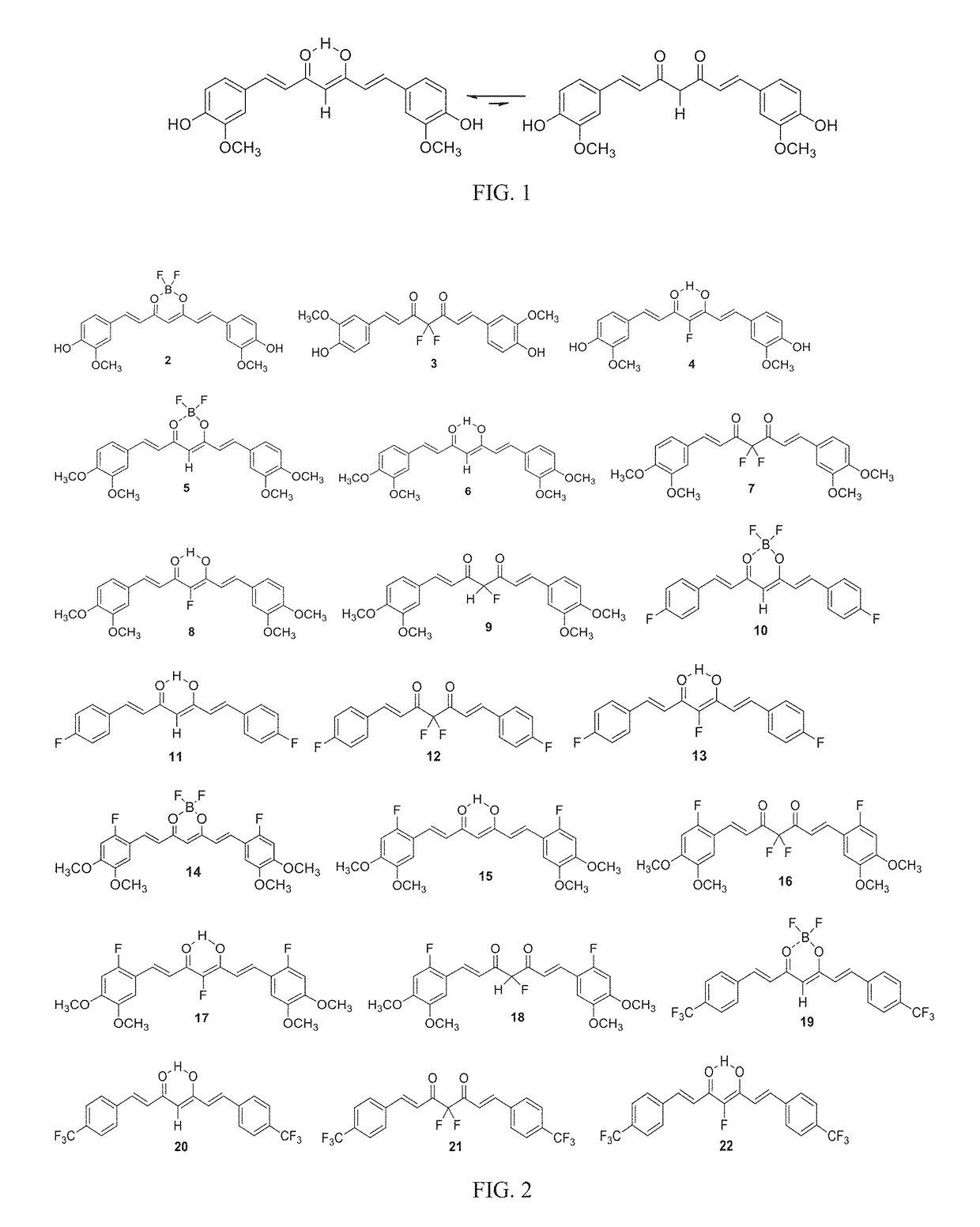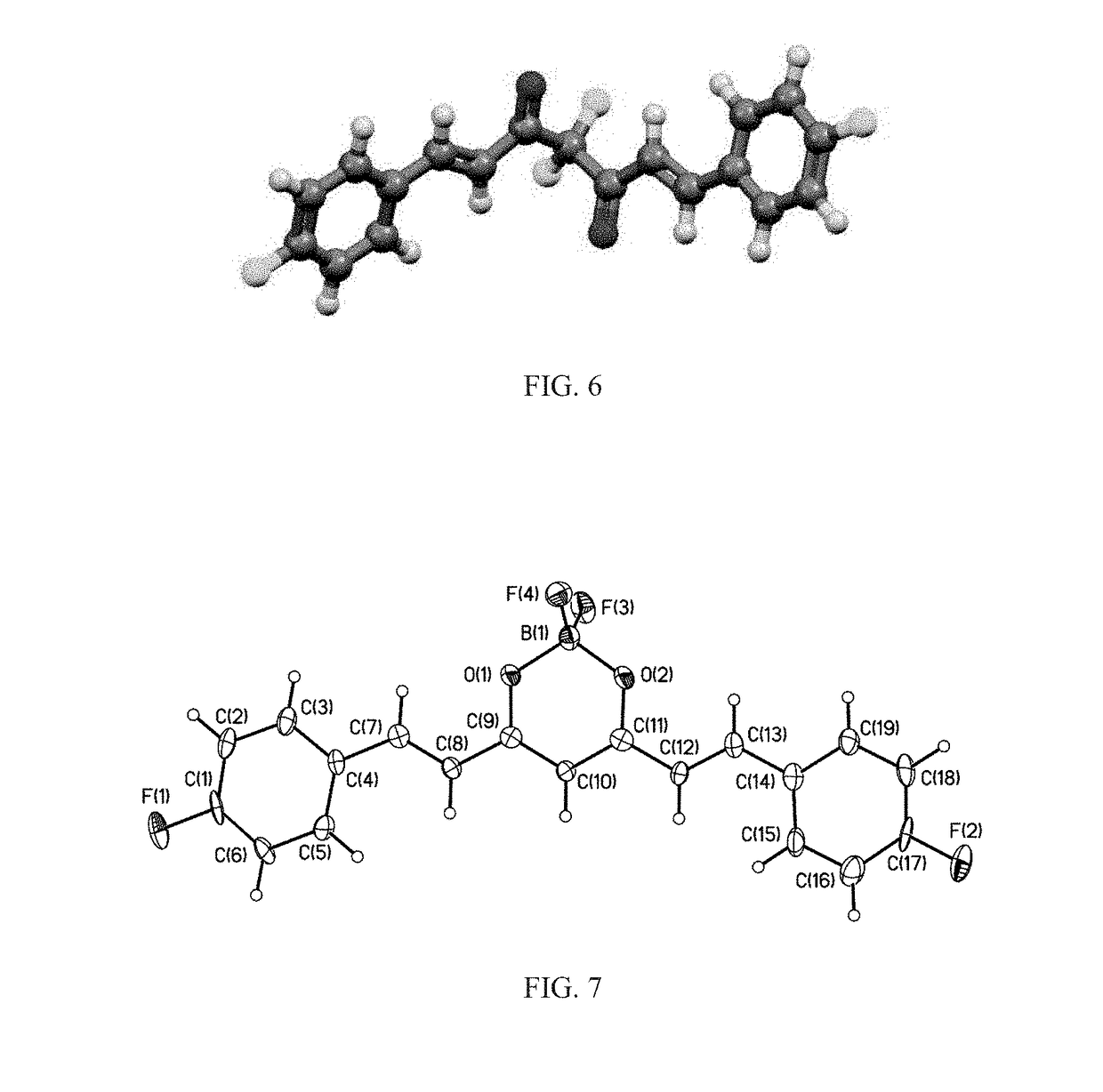Novel curcuminoid-inspired synthetic compounds as Anti-tumor agents
- Summary
- Abstract
- Description
- Claims
- Application Information
AI Technical Summary
Benefits of technology
Problems solved by technology
Method used
Image
Examples
example 1
CUR Inspired Compounds Bearing Fluorinated Moieties
[0181]Studies were performed to identify suitable solvents for the reaction of 1 with Selectfluor. Experiments were performed by using 0.1 mmol of CUR and 1.1 and 2.1 equivalents of Selectfluor, and the progress of the reactions were monitored by 19F NMR (and by TLC). 19F NMR provided a convenient and direct method to gauge chemoselectivity in different solvents. Apart from F-CUR and F2-CUR, formation of CUR-BF2 adduct was observed in some solvents, notably in water and in acetone under microwave irradiation (more in section 2.2). Presence of a distinct doublet at δ−195 ppm (JHF=50 Hz) signified the 1,3-diketo-tautomer of F-CUR present in different proportions in some solvents. Application of microwave (MW) increased the proportion of CUR-BF2 adduct in acetone as solvent, seen in Table 1.
TABLE 119F NMR monitoring of solvent effect on fluorination selectivitya19F NMR signal19F NMR signal at19F NMR signal19F NMR signalat −195 ppm (d)−...
example 2
Mono- and Di-Fluorinated CUR Inspired Compounds Possessing Non-Fluorinated Aryls
[0255]Curcuminoids were formed by forming a reflux solution from 10 mmol (1 g) acetylacetone ((3Z)-4-hydroxypent-3-en-2-one) with in 50 mL dichloromethane (DCM, distilled from P2O5) under a nitrogen atmosphere for 12 hours. Boron trifluoride complexed to diethyl ether (BF3.Et2O, ˜48%; 2.126 g, 1.89 mL, 15 mmol, 1.5 equiv) was slowly added over a period of 5 minutes and the reaction mixture was refluxed (41° C.) for 12 hrs, as seen in FIG. 4. The product, i.e. boron-difluoride adduct of acetylacetone, was cooled to room temperature and quenched with 15 mL deionized water. The DCM layer was separated, and the aqueous layer was discarded. The reaction mixture was subsequently washed several times with DI water (3×15 mL) until the aqueous layer had a pH of about 7. The organic product was isolated and 6 mmol (887 mg) of the boron-difluoride adduct of acetylacetone mixed with 2.2 equivalent (13.2 mmol) of an ...
example 3
Mono- and Di-Fluorinated CUR Inspired Compounds Possessing Fluorinated Aryls
[0260]Curcuminoids were formed by forming a reflux solution from 10 mmol (1 g) acetylacetone ((3Z)-4-hydroxypent-3-en-2-one) with in 50 mL dichloromethane (DCM, distilled from P2O5) under a nitrogen atmosphere for 12 hours. Boron trifluoride complexed to diethyl ether (BF3.Et2O, ˜48%; 2.126 g, 1.89 mL, 15 mmol, 1.5 equiv) was slowly added over a period of 5 minutes and the reaction mixture was refluxed (41° C.) for 12 hrs, as seen in FIG. 4. To form fluorinated aryl compounds, a mixture of 6 mmol the boron-difluoride adduct of acetylacetone (887 mg) was suspended in ethyl acetate (60 mL) under stirring and nitrogen atmosphere, A fluorinated aryl-aldehyde (2.2 equivalence, 13.2 mmol, 1.638 g) was added in one portion, followed by slow addition of 0.22 equivalents N-butylamine (1.32 mmol, 96.5 mg, 130 μL) over 20 min. The reaction mixture was stirred continuously at room temperature overnight. The reaction mix...
PUM
| Property | Measurement | Unit |
|---|---|---|
| Molar density | aaaaa | aaaaa |
| Molar density | aaaaa | aaaaa |
| Molar density | aaaaa | aaaaa |
Abstract
Description
Claims
Application Information
 Login to View More
Login to View More - R&D
- Intellectual Property
- Life Sciences
- Materials
- Tech Scout
- Unparalleled Data Quality
- Higher Quality Content
- 60% Fewer Hallucinations
Browse by: Latest US Patents, China's latest patents, Technical Efficacy Thesaurus, Application Domain, Technology Topic, Popular Technical Reports.
© 2025 PatSnap. All rights reserved.Legal|Privacy policy|Modern Slavery Act Transparency Statement|Sitemap|About US| Contact US: help@patsnap.com



